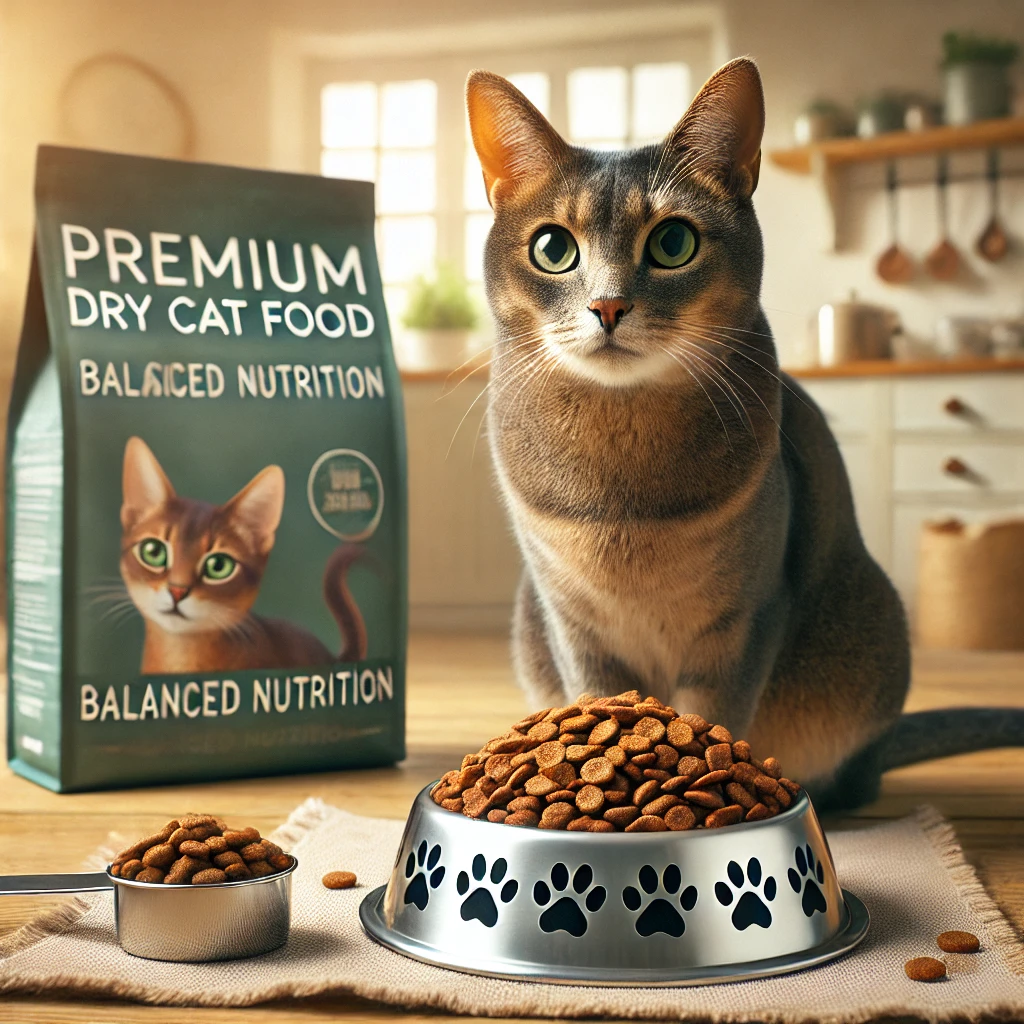Cats are known for their independent nature, but when it comes to nutrition, they rely entirely on us. Feeding the correct amount of dry food is vital for maintaining a healthy weight, supporting energy levels, and providing essential nutrients. Overfeeding can lead to obesity, diabetes, and joint problems, while underfeeding may result in malnutrition, lethargy, and weakened immunity.
Proper portion control ensures your cat gets everything they needs without the risks associated with overindulgence or nutritional deficiencies.
Key Factors That Determine Dry Food Portions
1. Age and Life Stages
- Kittens: These little bundles of energy need more calories to support growth and development. Divide their food into 3-4 meals a day.
- Adult Cats: Require balanced nutrition to maintain weight and activity levels. Two meals per day are generally sufficient.
- Senior Cats: Older cats may need fewer calories due to reduced activity but benefit from nutrient-dense food for joint and immune health.
2. Activity Level
Active outdoor cats or those who engage in regular play burn more calories and require more significant portions. Sedentary indoor cats need fewer calories to avoid weight gain.
3. Breed and Size
Giant breeds like Maine Coons need more food than smaller breeds like Siamese. Consider your cat’s body structure and metabolism when calculating portions.
4. Health Conditions
Cats with conditions like diabetes, kidney disease, or obesity may require special diets with adjusted portions. Always consult your vet for guidance in these cases.
How to Read and Use Feeding Guidelines on Dry Cat Food Packaging
Dry cat food packaging provides helpful feeding charts, but they’re not always tailored to every individual cat. Here’s how to interpret and customize these guidelines:
1. Decoding Portion Recommendations
Feeding charts typically provide suggested portions based on weight and life stage. Use these as a starting point and adjust based on your cat’s needs.
2. Understanding Calorie Content
Check the calorie density (kcal per cup) of the food. Foods with higher calorie content require smaller portions, while lower-calorie options may need slightly larger servings.
3. Mixed Feeding Adjustments
If you’re combining dry food with wet food, ensure the total calorie intake aligns with your cat’s daily requirements.
Let’s Take Guidelines of How Much Dry Food to Feed a Cat?
Tips for Measuring and Serving Dry Food
1. Use Accurate Tools
Always use a measuring cup or kitchen scale to serve the exact portion recommended. Avoid free-feeding, as it can lead to overeating.
2. Stick to a Feeding Schedule
Establishing regular feeding times (usually twice a day) helps maintain a routine and prevents your cat from overeating.
3. Account for Treats
Treats should only make up 10% of your cat’s daily caloric intake. Subtract treat calories from their main meals to maintain balance.
Choosing the Best Dry Cat Food
Not all dry cat foods are created equal. Here’s what to look for when choosing the best option for your feline friend:
1. Nutritional Quality
Opt for food labeled as “complete and balanced” by AAFCO standards. High-protein formulas with real meat as the first ingredient are ideal.
2. Specialized Formulas
- Grain-Free: Good for cats with sensitivities or allergies.
- High-Protein: Supports muscle maintenance and energy levels.
- Life-Stage Specific: Formulas designed for kittens, adults, or seniors ensure appropriate nutrition at every stage.
3. Trusted Brands
Consider reputable brands like Hill’s Science Diet, Royal Canin, and Blue Buffalo, which offer high-quality dry food tailored to various needs.
Monitoring Your Cat’s Health and Adjusting Portions
Regularly observing your cat’s condition is key to ensuring they’re getting the right amount of food. Here’s what to look for:
Signs of Overfeeding
- Rapid weight gain.
- Decreased energy levels.
- Vomiting or digestive issues.
Signs of Underfeeding
- Visible ribs or weight loss.
- Constant hunger or begging.
- A dull coat or low energy.
Making Adjustments
If you notice any of these signs, adjust portions gradually and monitor the results. For significant changes, consult your veterinarian.
FAQs
1. How do I calculate the right portion of dry food for my cat?
Use the feeding chart on the food packaging as a starting point, then adjust based on your cat’s weight, activity level, and age.
2. Can I free-feed my cat dry food?
Free-feeding is not recommended, as it can lead to overeating and obesity. Measured portions are a healthier choice.
3. How often should I feed my cat dry food?
Most adult cats do well with two meals a day. Kittens may require 3-4 meals, while seniors can be fed 2-3 smaller portions daily.
4. Is grain-free dry food better for my cat?
Grain-free food is beneficial for cats with sensitivities or allergies, but it’s not necessary for all cats. Consult your vet for personalized advice.
5. How can I transition my cat to a new dry food?
Gradually mix the new food with their current food over 7-10 days, increasing the proportion of new food daily to prevent digestive upset.
Conclusion
Feeding your cat the right amount of dry food is essential for their health, energy, and happiness. By considering factors like age, activity level, and health and choosing the best dry cat food, you can ensure your feline friend receives the nutrition they need to thrive. Remember to measure portions accurately, monitor their condition, and adjust as needed.
